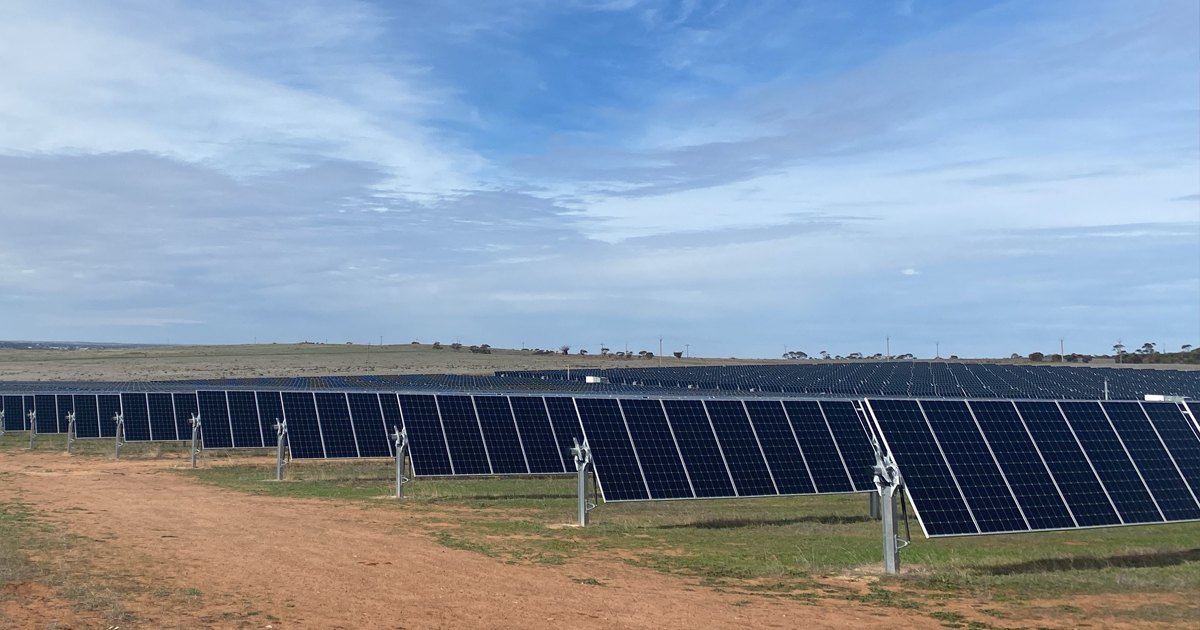
Tens of thousands of solar panels installed near Murray Bridge have been connected to an SA Water pumping station.
The Murray Bridge to Onkaparinga Pipeline is 50 kilometres long and delivers “raw” (untreated) water from the River Murray to several locations – Mount Bold Reservoir and a couple of water treatment plants situated in the Adelaide Hills.
In another step towards its “Zero Cost Energy Future”, SA Water has installed 34,272 solar panels at the pipeline’s second pump station in Rocky Gully. The panels will collectively generate an estimated 25,600 megawatt hours of solar electricity per year to power pumping operations – equivalent to the electricity requirements of approximately 4,000 SA households.
According to SA Water’s Nicola Murphy, the new installation will avoid around 11,000 tonnes of emissions annually.
Zero Cost Energy Future A Winner
The emissions reduction is great, but another major motivator for SA Water in going solar is its eye-watering electricity bill that has hit more than $80 million dollars annually in recent years.
“Now connected to our assets, these solar panels will significantly help to sustainably reduce our operating electricity costs and reliance on the national electricity grid, without compromising on the performance this vital pipeline plays in delivering trusted water for our customers,” said Ms. Murphy.
As big as the Rocky Gully project is, it’s just a small part of the organisation’s Zero Cost Energy Future initiative that has resulted in more than 360,000 ground-mount and rooftop panels installed at 33 sites to date. As well as solar panels, battery storage is also being rolled out at some sites. These solar + storage installations include projects at Aldinga and Myponga in Adelaide’s southern suburbs .
Among the more innovative PV projects is a fully redeployable solar system at Happy Valley Reservoir that uses Australian company 5B’s Maverick pre-wired and pre-configured “solar farm in-a-box” solution. Maverick technology may be utilised for Sun Cable’s proposed massive AAPowerLink in the Northern Territory, which at this point is to boast 17-20 GW of solar power capacity and 36-42 GWh of battery storage.
SA Water is pretty proud of its PV achievements.
“This initiative was designed by our people and shows South Australians leading the way with the smarts and skills to integrate renewable energy across existing plants, pump stations and other land holdings,” said Ms. Murphy.
Zero Cost Energy Future has captured attention across the water sector, being one of the largest renewable energy projects of its nature in the industry – both here and abroad. The project was a 2022 National Water Awards winner; taking out the Infrastructure Project Innovation Award (Metro).
The treatment and transport of water and sewage in Australia is a major electricity consumer. But like SA Water, many other utilities across the country are exploring or are already reaping the benefits of solar energy to reduce emissions and electricity costs. For example and across the border in Victoria, Melbourne Water’s 18 MW solar farm at a treatment plant in Bangholme will be activated later this year, and there’s a 9MW solar farm under construction at its Winneke Treatment Plant.

 RSS - Posts
RSS - Posts



Are home storage batteries economical in WA?
WA is one of the best places in Australia for battery payback, but even there they will generally only have a chance of paying for themselves if your evening electricity use is high. However, if you place a high value on having battery backup, they could be worth it for you. This article gives some more detail:
https://www.solarquotes.com.au/blog/tou-solar-batteries-savings/